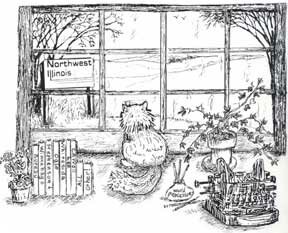
Discover rewarding casino experiences. 

Please Don't Quote Me Why is the dust in such a rage? It is the yearly caravan Of peddlers on their pilgrimage To southern marts; full of Japan And tin and wooden furniture That try to charm the passing eye And spices I am very sure Ne’er saw the shores of Araby! Well skilled in that smooth eloquence are they which steals away your every pence. |
Peddlers, once so prevalent on the dusty roads of early America, are little known today although we are familiar with the Avon lady or the Schwann man and recall the Fuller Brush man, the vacuum cleaner salesman; all those door-to-door salesmen selling Watkins, McNess or Rawleigh products and encyclopedias, Bibles, magazines, brooms, notions. Peddlers, so numerous at one time are barely thought of today even though they played a big part in the development of our history here in the Northwest of Illinois. Today’s peddlers we often see everyday because they are our neighbors just as yesterday’s peddlers might have been in town and hamlet of the earlier time. Actually, they roamed and wandered a great deal except perhaps in the winter when their horse or team rested and they built up a stock of goods to take on the road when mud season ended in the spring. A reference gives that in 1850 there were 10,669 peddlers in the U.S. and by 1860, 16,594; this we assume taken from the census. It was the heyday of peddlers who filled the roads, especially in the East and South, lesser so in the Midwest. There were doubtless, hundreds unlicensed inspiring the anonymous Connecticut poet to write the verse above. If peddlers were required to have a license here in the Northwest we didn’t find it in the county histories but grocers did. In the 1878 Carroll history one of the first licenses was obtained by Smith and Journey, Savanna, for twenty-five dollars in the first year after county hood was secured in 1839. A stiff amount. Surely S. and J. would have seen that peddlers, their competition, would have to have a license, too. The settled merchant/grocer was easily taxed while the itinerant peddler might slip away if not hunted down! The peddler was described as being resourceful and courageous; perhaps even a bit wild and daring, plodding as he did in the frontier wildernesses where who knows who or what might lie in wait to steal his pack or cash money. It did happen as the peddler usually traveled alone by foot but sometimes had a horse and cart or team and wagon fitted out ingeniously with high wheels to pass through mud and swamp, with fold-down wagon sides to hold hundreds of items one inside the other and draped from poles hung around the top or stuck into niche and knotholes and probably brightly painted or lettered with names of some product they sold ... Patent medicine or cleaning oils, fancy fabrics, tinware and notions galore. The peddler was thought to be just a little reckless (or lucky) because he would be going into the lawless lead mine camps up around Galena or floating into some sin-filled river camp on a boat, a flatboat used as a store for the goods. Who knew what desperado lurked in the jungle or growth in the snake-filled islands in the Mississippi! The peddler might sleep in a homesteader’s barn or a farmer’s shed but as often under the stars unless a wagon was shelter. Every night was an adventure. The late Etta Bollinger Gaul was a talented story-teller who recalled charming anecdotes and drew with her tales, vivid vignettes of her girlhood days so different than today. One of her favorite times was when the peddlers came. Many peddlers returned year after year and she like the Italian “linen man” who sold tablecloths, napkins, bureau scarves, doilies for chair arms and backs ... Good cloth, not poor. He’d show them how to tell if the damask was “real” by wetting the corner but darned if I recall what the test outcome was supposed to be!! He spoke with a heavy accent and in her imagination she traveled afar when he winked and gave her a penny. There’d also be the scissors-sharpener, the man who made tinware—coffee pots, teakettles, cups to use at the outside pump, pans for chicken feed, much more. Peddlers on foot like Etta’s “linen man” carried a huge rolled pack on their backs that might weigh up to a hundred pounds. It was usually wrapped in black oilcloth to keep the goods dry in rain or snow. If many years were spent carrying the pack, the peddler became bent when he walked without it. “Carting,” as it was sometimes called, if horse and cart were used, often used peddling as a step towards having a permanent spot ... A store such as Dexter Knowlton did in early day Stephenson County. Wanting to explore the “West,” the prairies of Illinois, he decided to leave the steep hills of his New York state, taking with him a pack of peddler’s goods to sell along the way. Arriving in Freeport as it was just beginning, he put together some of the funds he’d collected en route and settled into a store. Very soon he’d developed a bank and, in fact, imported the first safe in the town, bringing it by ox team from Chicago for the safe keeping of cash and valuables. Not long hence, he became a director on the board of the Galena and Chicago Railroad and never tired of selling. In his later years, he’d returned to his native state, New York, to Saratoga Springs for a rest but taking with him “Congress Water” to sell to speed the cure of the local springs. Some people are born to sell. Some were women who if they were dark-skinned might tell customers they were Armenian or Syrian even if they weren’t. Their exotic looks helped sell spices or scents or silken scarves pretending to be from the Middle Eastern Casbah or Turkish harem. The native American, too, might peddle something like wooden trenches or bowls he’d rough up a bit then say it was an ancient tribe who made them. But they were no more untrue stories than what the medicine man might tell of the elixir scented animal musk or the oil bubbling through the crack in the earth down around Jacobstown which certainly must be as big a find as the oil fields in Pennsylvania, eh? Cash money wasn’t the usual trade in a sale. It could be eggs or meal or pelts. Old rags (so much a pound), iron, scrap metal, old gold or something the homemaker had manufactured such as candles dipped in tallow at butchering time or some fine fitting aprons made from 1st year’s stock of calico or stripe ... Handmade wooden rakes or pitch forks; most anything could be bartered. The inventory was unbelievable even unto furniture that perhaps some local fellow peddled himself in the neighborhood such as John Leath. Many years ago Lucille Dale Schreiner said she lived in the house that Leath had lived in at 324 West Claremont. While in residence, he made furniture and went about selling it, she having a rocking chair her mother had bought of him years before. A note in the Lanark weekly in July of 1888 informed us that the family business would continue when it reported, “John S. Leath has moved to Lanark and business is so good that he has taken on an apprentice—He has a two week old baby boy.” The Leath family moved to Dixon first and expanded in scope till by the twentieth century had several stores, Leath Furniture, but which now have recently closed. More later as research adds up. The peddler had made a good thing of it, however.
Peddlers may have seemed a modest sort of business but like those storekeepers in permanent spots, could make a success of it by applying themselves to the elements that were important to the customer—and to themselves. Some were shady characters just like the storekeeper but for the most part they were honest and hardworking because otherwise their businesses wouldn’t continue ... Most peddlers followed a set route year after year though some did wander on to other climes ... Like the South in winter. Yes, the peddler was an integral part of our lives in the yesteryear though we hear little about them today nor even know they existed. The drawing here is a family one used in many places to illustrate the sort of conveyance a “certain gentleman” had and to which the customer in their lonely places looked forward to seeing each year. This was used in “The Old Country Store” by Gerald Carson which we enjoy so much. Next week a few more anecdotes about folks we know who were peddlers and went from there to other levels. Do you know any?
|




